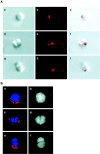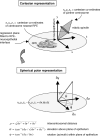Asymmetric segregation of Numb in retinal development and the influence of the pigmented epithelium
- PMID: 11466435
- PMCID: PMC6762650
- DOI: 10.1523/JNEUROSCI.21-15-05643.2001
Asymmetric segregation of Numb in retinal development and the influence of the pigmented epithelium
Abstract
Asymmetric segregation of cell-fate determinants during cytokinesis plays an important part in controlling cell-fate choice in invertebrates. During Drosophila neurogenesis, for example, asymmetric segregation of the Numb protein, which inhibits Notch signaling, is necessary for the two daughter cells of a division to have different fates. In vertebrates, the role of asymmetric segregation of cell-fate determinants is uncertain, and the way the process might be regulated is unknown. We have studied the orientation of cell divisions and the distribution of Numb in the developing rat retina. We show that, whereas most retinal neuroepithelial cells divide with their mitotic spindles oriented parallel to the plane of the neuroepithelium, a substantial minority divides with their spindles oriented perpendicularly. The proportion of these vertically dividing cells changes during development, peaking around the day of birth. Numb appears to be inherited only by the apical daughter cell when a neuroepithelial cell divides vertically. Similarly, in dissociated cell cultures, some retinal neuroepithelial cells divide asymmetrically and distribute Numb to only one of the two daughter cells, suggesting that the dissociated cells can retain their polarity in vitro. Using retinal explant cultures, we find that the retinal pigment epithelium apparently promotes vertical divisions in the neural retina. To our knowledge, this is the first evidence that asymmetric segregation of cell-fate determinants may contribute to cell diversification in the mammalian retina and that an epithelium controls this process by influencing the plane of division in the adjacent neural retina.
Figures







References
-
- Cepko CL. The roles of intrinsic and extrinsic cues and bHLH genes in the determination of retinal cell fates. Curr Opin Neurobiol. 1999;9:37–46. - PubMed
-
- Chang JT, Esumi N, Moore K, Li Y, Zhang S, Chew C, Goodman B, Rattner A, Moody S, Stetten G, Campochiaro PA, Zack DJ. Cloning and characterization of a secreted frizzled-related protein that is expressed by the retinal pigment epithelium. Hum Mol Genet. 1999;8:575–583. - PubMed
-
- Chenn A, McConnell SK. Cleavage orientation and the asymmetric inheritance of Notch1 immunoreactivity in mammalian neurogenesis. Cell. 1995;82:631–641. - PubMed
Publication types
MeSH terms
Substances
LinkOut - more resources
Full Text Sources
